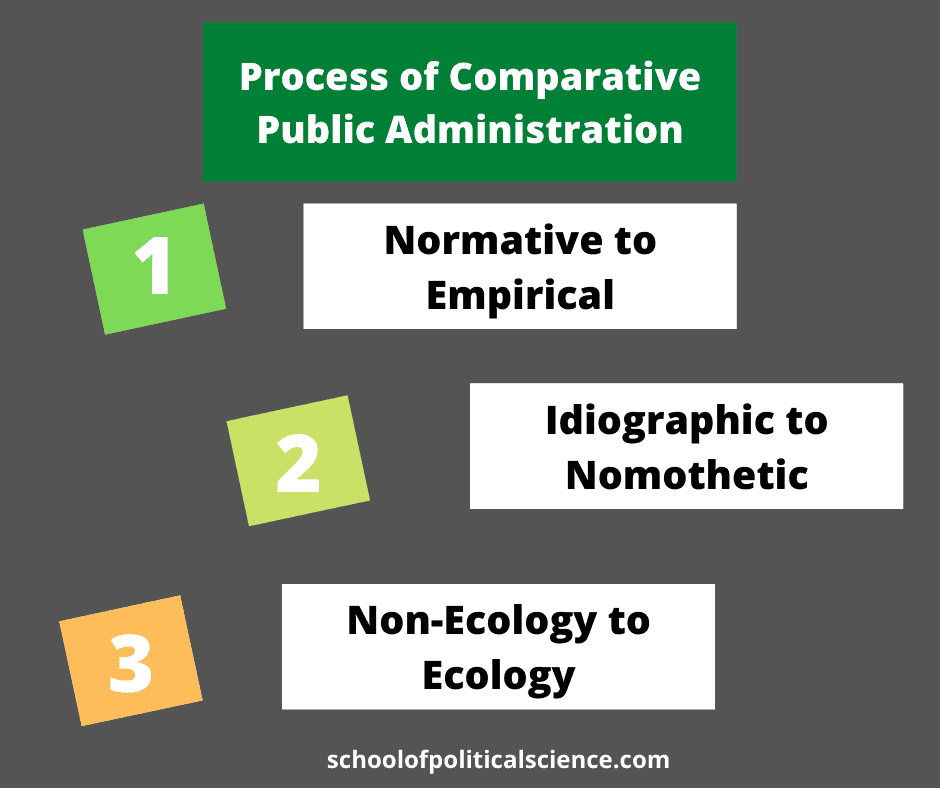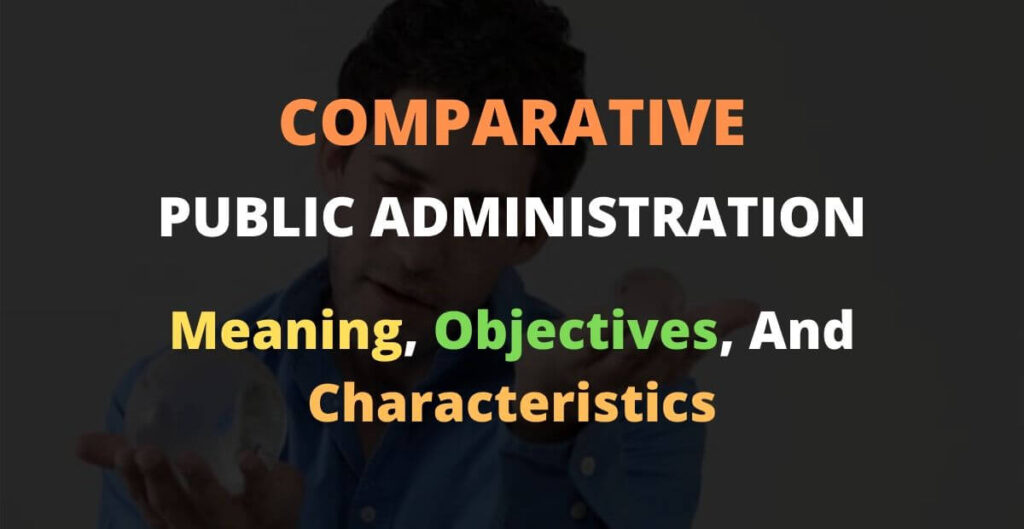Comparative Public Administration is one of the counteractions that are available against the conventional theory of public administration. It is a sub-field of public administration.
Must Read– Top 10 Public Administration Jobs You Should Consider for a Rewarding Career
What is Comparative Public Administration?
Comparative public administration is defined as the comparative study of administrative systems of different countries. It has been broadened and deepened by the interest of scholars in the administration of Third World countries, especially after World War II.
It is also considered a movement that seeks to transform the idea of public administration from idealist to empirical and pragmatic. It seeks to make public administration universal, free from particular country-centric tendencies. It has made public administration ecological.
By the study of comparative public administration, you can understand the administrative structure and its functioning in different settings and associations or countries and what it does, and why it works. It also helps to add and improve theories so as to lead to a strong and practical theory of the subject with the help of empirical experiments and analysis.
Evolution of Comparative Public Administration
The comparative perspective in any branch of social science is not very old. Although in ancient times Aristotle initiated a comparative discussion between the city-states of Greece. Nevertheless, it can be said that this view did not become very popular in later discussions of political science.
The real discussion of comparative governance began in the aftermath of World War II, especially in the 1950s. Almond, Powell, Coleman, Apter, Lucian Pye, etc., present comparative analysis in a larger field of comparative politics.
Undoubtedly, this view of comparative politics has encouraged the interpretation and analysis of comparative public administration. Many countries gained independence after the Second World War. The first challenge of those newly independent countries was rapid socio-economic development. This requires a development administration.
Must-Read- 5 Phases Of The Evolution Of Public Administration
A clear comparative discussion between the administrations of different countries in a particular environment was needed to dispel doubts about what that development administration would look like. Because the administrative model of the West can never be applied to these newly independent countries to get good results.
As a result of comparative public administration, it is possible to arrive at what kind of administration is most conducive to the environment of those countries.
Three Different Processes of Comparative Public Administration
There are three different processes that contributed to Comparative Public Administration (CPA).

1. Normative to Empirical
Before the rise of CPA, public administration was very norm conscious. There is a kind of set of formulas and public administration in any country has to adapt to that kind of formula for making public administration efficient.
But after the world war, public administration focused on empirical reality. On the basis of that reality, public administration would be set up. So it was more focused on context rather than the norm.
2. Idiographic to Nomothetic
Idiographic means an understanding of a specific situation and identifying the unique characteristics of a particular administration. Instead of finding the uniqueness of a particular administration now, the focus is more on generalization. So that we can understand reality from a very abstract point of view.
3. Non-Ecology to Ecology
Instead of only focusing on administration it needs to be understood with reference to social, political, and cultural context. Unless or until you know the ecology (Social, economic, and cultural environment), it is very difficult to understand the nature of the administration.
Comparative Administrative Group (CAG)
Comparative public administration gained prominence in 1962 when the Ford Foundation received significant funding to run the Comparative Administrative Group (CAG) within the American Society for Public Administration.
Throughout the sixties, the CAG organized many research, essays, experimental lectures, and special seminars with administrators.
This CAG was led by Fred Riggs. He gave a theoretical form to comparative public administration.
He spreads the discussion of public administration outside the United States, especially in Third World countries. And facilitates the path of comparative analysis within the administrations of Third World countries. That is why Fred Riggs has been called the father of comparative public administration for his outstanding contributions.
The other contributors to this field are Leonard White, Robert Dahl, Feral Heady, Ramesh Arora, Paul Mayer, etc.
But in 1971 the Ford Foundation stopped funding because they felt that field surveys, identification of various real problems, and their solutions were not important in the CAG’s research. Their complaint was that the CAG was more inclined to focus on theoretical discussions or new theories.
Objectives of Comparative Public Administration
The main objective of comparative public administration is the classification of administrative systems. In the question of classification, there is cause-and-effect research to know the administrative similarities and differences of different countries based on experience.
As new public administration takes refuge, comparative public administration does not. It believes in the notion of value neutrality.
With Farrell Heady’s analysis in mind, the objectives of comparative public administration can be listed in the following points.
- One of the aims of this is to build enlightened knowledge by changing the previous statements about public administration.
- Public administration research should be expanded with development administration in mind. The nature of development administration will be determined by a precise comparative discussion of the administration in different countries.
- One of the purposes of comparative public administration is to build a general management model.
- A comparative analysis will be done on the ongoing problems of public administration.
- Another important objective is to search for theories by doing comparative research on public administration in different countries. And to put those theories into practice.
Must Read- Development Administration: Meaning, Features, and Challenges
Characteristics of Comparative Public Administration
From the above discussion, some features of comparative public administration can be identified. They are –
- This is a relatively new topic in public administration.
- Comparative public administration has a large number of contradictory discussions. Researchers from different disciplines may have come here, but there is a lot of discussion on the subject.
- The application of the scientific method in the discussion of comparative public administration is particularly noteworthy.
- Since the Ford Foundation of the United States contributed financially to its development, U.S. researchers and administration experts dominated this particular discipline.
- Comparative public administration has been interested in theory building and moving towards the administrative problems of the developing state and its possible solutions.
- Apart from these, It makes students, teachers, researchers, administrators, and experts aware of the public administration of other states. In addition, another state can be established by bringing administrative institutions and administrative procedures from other states and this is possible only through comparative public administration.
Significance of Comparative Public Administration
Comparative public administration is probably one of the most discussed and enriched topics in the modern discussion of public administration. At the same time, comparative public administration has established its importance and significance in intellectual discourse and in the practical world.
The comparative discussion of the administrative structure of different political systems and their functions helps to form the theory. Many people think that if the theoretical discussion is taken forward through this kind of discussion, then the matter also becomes scientific. In addition, the characteristics of the administrative system of different states can be easily mastered through comparative public administration.
The significance of comparative public administration can also be noticed in practical matters. Through comparative public administration, administrators, policymakers, and researchers can understand the successes and failures of administrative structures in different environments. It is possible to know what kind of administrative structure can be successful in any environment through comparative public administration.
Thus, in different states, in different environments, in different political and cultural contexts, it is possible to build a political system that is useful or consistent if one knows what kind of administrative structure has succeeded, what kind of administrative feature has succeeded or what administrative feature has failed. .
Conclusion
From the above discussion on Comparative Public Administration, it can be concluded that The contribution of the comparative approach to administrative research at present is particularly significant.
However, when the CAG closed in the 1970s and merged with the International Committee of the American Society for Public Administration, it was doubtful that the practice of comparative public administration would cease. But it turns out that the potential for comparative research is growing in the modern era.
In the context of globalization, exchanges between states have also increased. That is why different states are deepening the relationship between them. As a result, the possibility of comparative discussions is increasing. The bureaucracy of different political systems, government management systems, relations between government and non-government organizations, etc. can be discussed with great success in today’s age.
Let me share with you what you have learned from “Comparative Public Administration: Meaning, Objectives, And Characteristics”.
Share this with needful students as much as you can.
Must Read-
- New Public Management: Meaning, 10 Principles, And Features
- Good Governance: Definitions, 8 Characteristics, And Importance
- E-Governance: Meaning, Objectives, Features, and 4 Types
References
- Bhattacharya, Mohit. New Horizons of Public Administration. Jawahar Publishers & Distributors, 2011.
- Chakrabarty, Bidyut, and Bhattacharya, Mohit. Public Administration: a Reader. Oxford University Press, 2007.


Comments are closed.